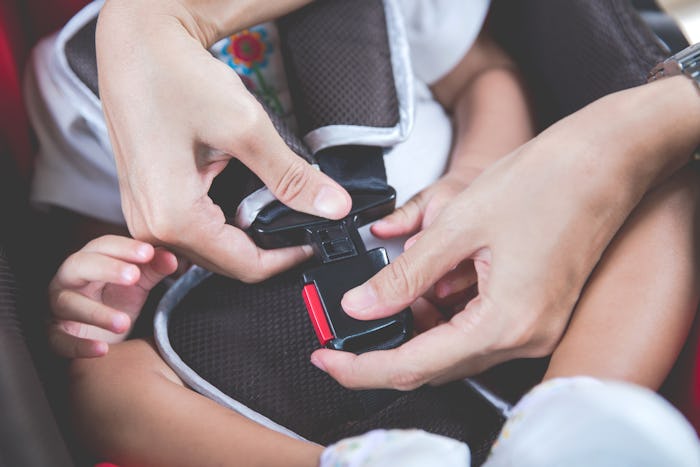Life

A parent's main job is to keep their child safe and, for the most part, they do a good job. Unfortunately, there is one area where parents struggle to protect their kids 100 percent — the car. Due to the ever-evolving research and guidelines, there are a lot of common car seat mistakes parents make without realizing it.
Car seat mistakes are seen everywhere, not just on the roads. Movies and marketing ads often feature improper car seat usage. And if parents see something enough times, even if it's done wrong, some start think it's the correct way. That can't happen — kids need to be as safe as possible, especially when riding in cars.
"The leading cause of death in kids between ages 3 and 14 is still car crashes," Christie Heltzell, a child passenger safety advocate and former technician with Safe Kids Worldwide, tells Romper. "When you then take into account that there's so much misinformation, confusing labels, questionable marketing tactics, and even lack of good, honest help, it's no wonder that 72 to 84 percent of car seats are being used critically wrong, meaning that there's a potentially deadly mistake in safety for three out of four kids."
It important to review the following car seat mistakes parents make, to help you not make them, and keep your kids as safe as possible.
1
They Don't Put The Chest Clip In The Right Place
The chest clip is "designed to be a pre-crash positioner and to break on impact," Heltzell says. In an accident, your child's body may be propelled forward, and that is made more dangerous if the chest clip is in the wrong place. "You don't want the chest clip breaking on your child's neck or their soft stomach — that will cause harm, even bleeding to internal organs," Heltzell says. "When placed correctly, between nipple and armpit level (as seen in this photo), it's on the solid sternum and the rib cage, which protects the organs."
2
They Buckle Kids In With Twisted Straps
There shouldn't be any twisting of any strap on your child's car seat, according to Safe Ride 4 Kids. The organization added that if the straps are twisted, "they may not distribute the weight correctly and cause injury."
3
They Don't Secure The Straps
The "pinch test" is what many experts tell parents to use when securing their little one in a car seat. The straps must be snug to do its job of keeping your kid from harm in an accident. According to the organization Safe Kids, parents should tighten the straps until they cannot pinch any part of the belt between two fingers.
4
They Don't Have The Top Harness In The Correct Place
Heltzell also tells Romper to be sure the top of the harness goes into the back of the car seat level with or below your baby's shoulders for rear-facing seats. For forward facing, the harness should be at or just above.
5
They Don't Properly Secure The Seat To The Car
Many car seat manufacturers have videos in addition to written manuals to help you install your child's seat. But it isn't always an easy thing to do, and do correctly. There are car seat inspection locations all over the country to help.
6
They Don't Remove Their Child's Winter Coat
"Thick winter coats just aren't safe when mixed with harnesses that need to fit snugly," Heltzell says. "Coats are designed to retain air, but in an accident, that air compresses and the straps that seemed tight over the air-filled coat are dangerously loose." Simply take your child's coat off, and place it over her to keep warm.
7
They Add Extras
There are a lot of add-ons sold separately and available to fit with your car seat, but the safety rule is to not buy any extras as they can compromise safety. According to the organization Car Seats For The Littles (CSFLT), head rests, infant support inserts, shoulder pads, harness covers, custom covers, seat protectors, and all non-regulated car seat items, "could alter the way [the car seat] is designed and tested to perform in a crash, resulting in serious injury or death." Any blankets can go over the belts, not under.
8
They Move Their Child From Rear- To Forward-Facing Too Soon
The American Academy of Pediatrics (AAP) set guidelines that state children should be rear-facing until they are at least 2 years of age or reach the highest weight or height allowed by the manufacturer of the seat.
9
They Buy A Used Seat
According to the AAP, used car seats can be dangerous, as you can't be sure if it was recalled or was involved in an accident, which compromises its safety. We don't encourage using old car seats.